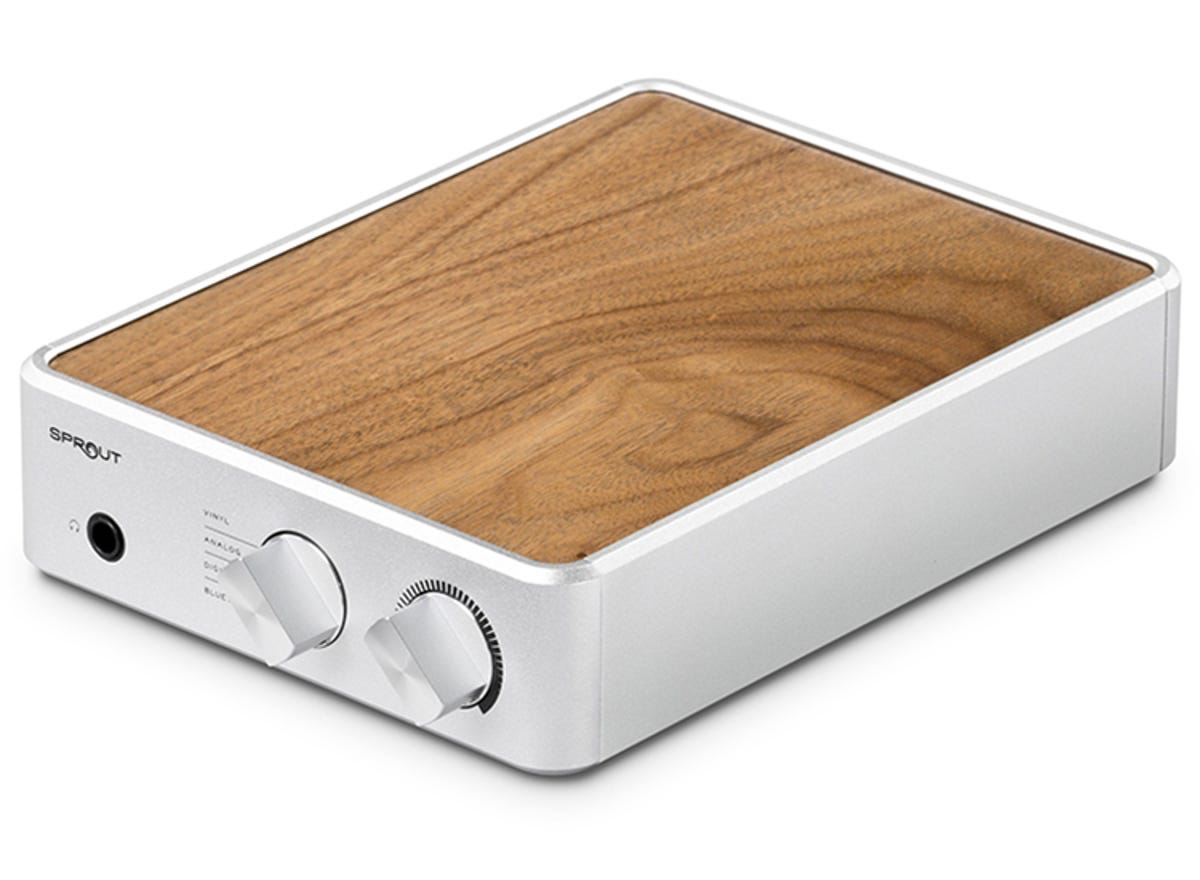
Music Direct
PS Audio is an American high-end audio company with a long track record making innovative products, but the little Sprout feels like a fresh start. First there’s the clean look, the Sprout’s aluminum housing frames a real walnut top cover, and the front panel has just two knobs, one handles input selection, the other volume. This little guy is easy to understand and play; few consumer electronics are as user-friendly — kudos to PS Audio for that!
The Sprout jam-packed with features: there’s a phono preamp for turntables; a headphone amp; a high-resolution 192kHz/24-bit digital converter; and AptX Bluetooth. All of that good stuff is squeezed into a body that’s 6 inches wide by 8 inches deep by 1.75 inches thick (152 by 203 by 44mm). Rear panel connectivity is generous, considering the limited space for jacks: there’s a coaxial digital input; USB port, stereo RCA turntable inputs; 3.5mm stereo analog input; a variable 3.5mm stereo analog output that can be hooked up to a subwoofer, power amp, or powered speakers; and speaker wire binding posts.
I like that there’s no wall wart — the power supply is built into the Sprout — but those cheesy plastic speaker connectors seem out of place in a premium-priced component like this. The Sprout’s Class D amp is rated at 50 watts per channel for 4-ohm speakers, and 33 watts per channel for 8-ohm speakers. I used Wharfedale Jade 3 speakers for all of my listening tests.
The Sprout is a little thing, but the sound is sweet and very easy to listen to. Audio Fidelity’s remastered LP “Herbie Mann at the Village Gate,” a live recording from 1961, felt a little lackluster, but I loved the way Mann’s flute floated over his limber rhythm section. Most integrated amps in the Sprout’s price class don’t have built-in phono preamps, so if you’re into vinyl, that might tip your decision over to the Sprout.


Music Direct
I played my Oppo BDP 105 Blu-ray player through the Sprout’s digital converter. The sound was engaging, bigger and brawnier that what you might expect from such a little amp. The Herbie Mann CD’s tonal balance was lighter than the vinyl’s sound, but still on the rich side.
One thing’s for sure, the Sprout isn’t bright. My NAD C 316BEE integrated amplifier was tonally leaner and more immediate, and the music’s pulse set my toes a tappin’ more than the Sprout ever did. The Sprout’s bass was thicker and went deeper, but definition was only so-so. I also tried the tiny Micromega MyAmp integrated amplifier, and it was the most transparent of the three amps (review to come).
The Sprout doesn’t have a power-on indicator light, and the power switch is located on the rear panel, so I left the amp on 24-7. More gripes, there’s no remote control, the built-in headphone amp’s sound was a tad thin, and I heard a quiet buzz lurking in the background when I listened to Bowers & Wilkins C5 Series 2 headphones. I have an early production Sprout, I hope some of these issues are corrected soon.
The PS Audio Sprout’s US price is $800. It’s £650 in the UK, and AU$997 in Australia.




